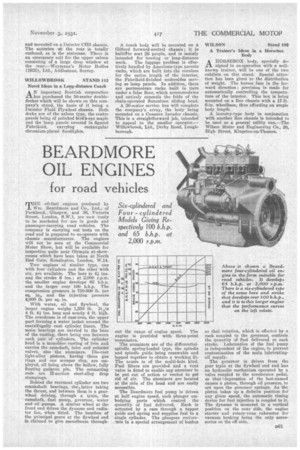BEARDMORE OIL ENGINES
Page 147

If you've noticed an error in this article please click here to report it so we can fix it.
for road vehicles
TE oil-fuel engines produced by Wm. Beardmore and Co., Ltd., of Parkhead,. Glasgow, and 80, Victoria Street, London, S.W.1, are now ready to be marketed for use in goads and passenger-carrying road vehicles. The company is carrying out tests on the road and is prepared to co-operate with chassis manufacturers. The engines will not be seen at the Commercial Motor Show, but will be available for inspection quite near Olympia at, showrooms which have been taken at North End Gate, Kensington, London, W.14.
Two engines of similar type, one with four cylinders and the other-with six, are available. The bore is 41 ins. and the stroke 6 ins.; at 2,000 r.p.ixt. the smaller engine develops 65 b.h.p. and the larger over 100 b.h.p. The compression pressure is 750-800 lb. per sq. in., and the injection pressure 4,000 lb. per sq. in.
With water, oil and flywheel, the larger engine weighs 1,350 lb. It„is 4 ft. 41 ins, long and nearly 4 ft. high. The crankcase is of cast-iron, the upper part forming a water jacket around the centrifugally cast cylinder liners. The main bearings are carried in the base of the casting, there being one between each pair of cylinders. The cylinder head is a monobloc casting of iron and carries the-camshaft, inlet and exhaust valves' also the atomizers. Die-cast light-alloy pistons, having 'three gas rings and one scraper ring, are employed, all being above the hollow, fully floating gudgeon pin. The connecting rods are H-section steel-alloy drop stampings.
Behind the rearmost cylinder are two crankshaft bearings, the ,latter taking the thrust, and between them is a gearwheel driving, through a train, the camshaft, fuel pump, governor, water and oil pumps. A similar wheel at the front end drives the dynamo and radiator fan, when fitted. The location of the principal gears at the flywheel end is claimed to give smoothness through out the range of engine speed. The engine is provided with three-point suspension.
The atomizers are of the differentialspindle spring-loaded type, the spindle and spindle guide being renewable and lapped together to obtain a working fit. The nozzle is of the multi-hole kind. Fuel filters are provided and a vent valve is fitted to enable any atomizer to be put out of action or vented to get rid of air. The atomizers are located at the side of the head and are easily accessible.
The Beardmore fuel pump is driven at half engine speed, each plunger embodying ports which control the quantity of fuel delivered. Each is actuated by a cam through a tappet guide and spring and supplies fuel to a single cylinder. The plungers reciaroTate in a special arrangement of bushes
so that rotation, which is effected by a rack coupled to the governor, controls the quantity of fuel delivered at each stroke. 'Lubrication of the fuel pump is independent of the engine, to prevent contamination of the main lubricatingoil supply.
The governor is driven from the gear Vain at the flywheel end and has an hydraulic mechanism operated by a valve coupled to the accelerator pedal, so that 'depression of the last-named causes a piston, through oil pressure, to act upon the governor springs. As the piston takes up a definite position for any given speed, the automate timing device for fuel injection is coupled to it. The dynamo is mounted in a vertical position on the near side, the engine starter and rotary-vane exhauster for vacuum braking being the only accessories on the off side.








































































































































































































































